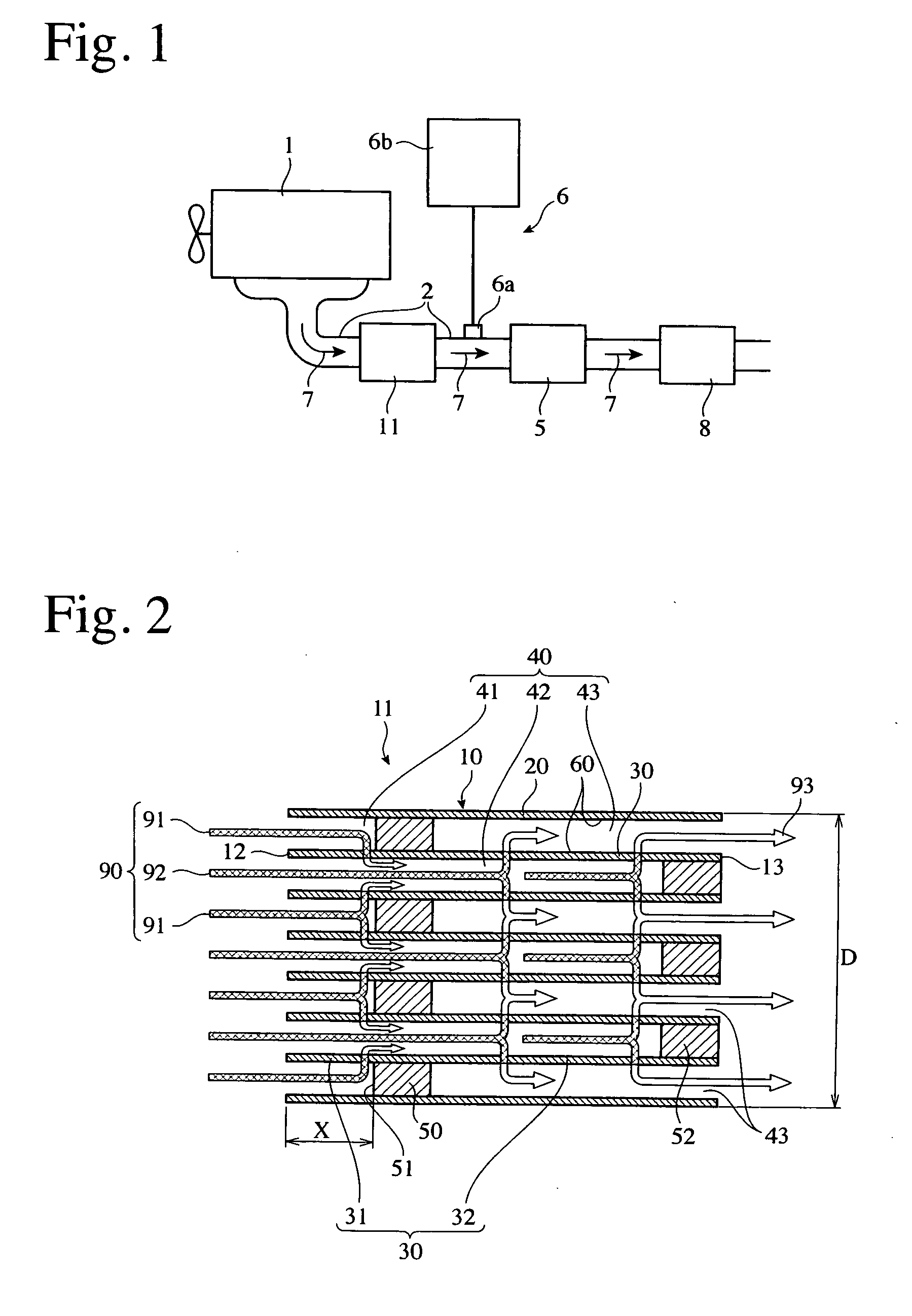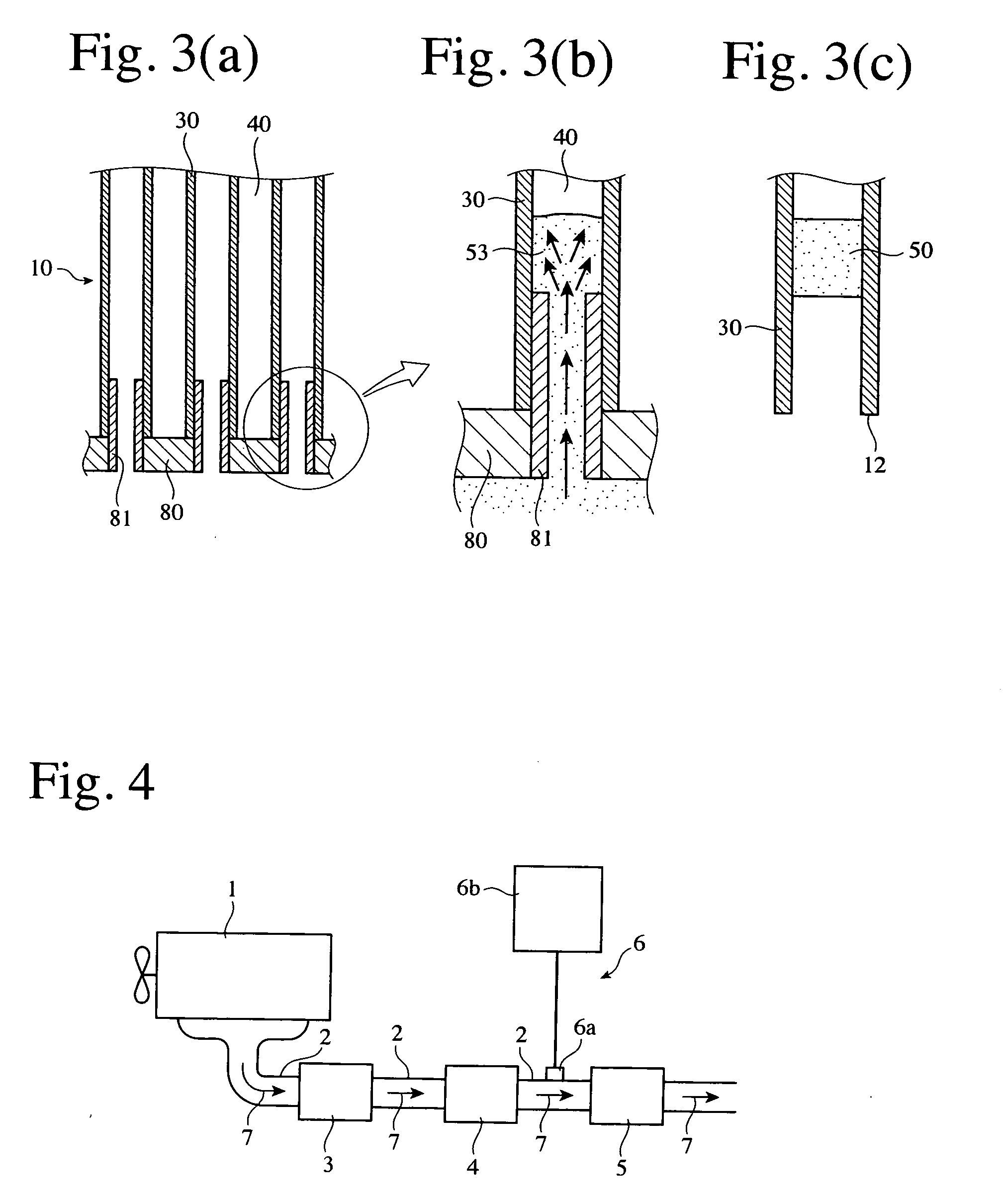Exhaust gas-cleaning apparatus
- Summary
- Abstract
- Description
- Claims
- Application Information
AI Technical Summary
Benefits of technology
Problems solved by technology
Method used
Image
Examples
second embodiment
[6] Second Embodiment
[0054] In the second embodiment shown in FIG. 7, a honeycomb filter 11 and an SCR catalytic converter 5 are contained in one case 21. The case 21 has an upstream-side opening connected to an exhaust gas path 2a communicating with a diesel engine, and a downstream-side opening connected to an exhaust gas path 2b communicating with an ammonia slip means 8. The case 21 is constituted by two portions 21a, 21b, both case portions 21a, 21b being gas-tightly connected via an annular member 22 by welding, etc. The annular member 22 is connected to a pipe 6c communicating with a reducing agent reservoir 6b, and a tip end of the pipe 6c is connected to a nozzle 16 substantially perpendicular to the longitudinal direction of the case 21.
[0055] In the example shown in FIG. 8, the nozzle 16 is a linear nozzle fixed to the annular member 22, which has pluralities of openings 16a directed substantially perpendicularly to the longitudinal direction of the case 21. Because the ...
example 1
[0062] A honeycomb filter 11 for use in an exhaust gas-cleaning apparatus for a diesel engine was produced by the method shown in FIG. 3. Cordierite-forming material powder containing kaolin, talc, silica, aluminum hydroxide and alumina was mixed with a molding aid, a pore-forming agent and a predetermined amount of water, and then fully blended to prepare a ceramic material extrusion-moldable to a honeycomb structure. This ceramic material with moldable consistency was extrusion-molded to a honeycomb structure having large numbers of rectangular-cross-sectioned flow paths partitioned by porous cell walls inside a peripheral wall. The resultant green body was dried and fired to produce a ceramic honeycomb structure 10 having a diameter D of 267 mm and a length L of 305 mm, with porous cell walls 30 having thickness of 0.3 mm, a pitch of 1.50 mm, porosity of 65% and an average pore diameter of 20 μm.
[0063] As shown in FIG. 3(a), a resin mask 80 provided with slurry-introducing paths...
example 2 and 3
[0068] Using the same honeycomb filter 11 as in Example 1 except that the distance X was changed to 40 mm (Example 2) and 30 mm (Example 3), respectively, the exhaust gas-cleaning apparatus shown in FIG. 1 was produced. The displacement V (liter) of the diesel engine, the diameter D (mm) of the honeycomb filter, D / V, and the distance X are shown in Table 1.
[0069] An exhaust gas at 200° C. was caused to flow through the honeycomb filter in each an exhaust gas-cleaning apparatus for 2 hours, so that PM was accumulated in the honeycomb filter 11. An exhaust gas at 350° C. and an unburned fuel were then supplied to the honeycomb filter 11, and after 5 minutes from starting the burning of PM, the temperature of the exhaust gas was lowered to 100° C., and the supply of the unburned fuel was stopped. After 2 minutes passed, the temperature of the exhaust gas discharged from the honeycomb filter 11, and the conversion ratio of NOx to N2 in the SCR catalytic converter 5 were measured. The r...
PUM
| Property | Measurement | Unit |
|---|---|---|
| Sheet carrier density | aaaaa | aaaaa |
| Volume | aaaaa | aaaaa |
| Volume | aaaaa | aaaaa |
Abstract
Description
Claims
Application Information
 Login to View More
Login to View More - R&D
- Intellectual Property
- Life Sciences
- Materials
- Tech Scout
- Unparalleled Data Quality
- Higher Quality Content
- 60% Fewer Hallucinations
Browse by: Latest US Patents, China's latest patents, Technical Efficacy Thesaurus, Application Domain, Technology Topic, Popular Technical Reports.
© 2025 PatSnap. All rights reserved.Legal|Privacy policy|Modern Slavery Act Transparency Statement|Sitemap|About US| Contact US: help@patsnap.com



